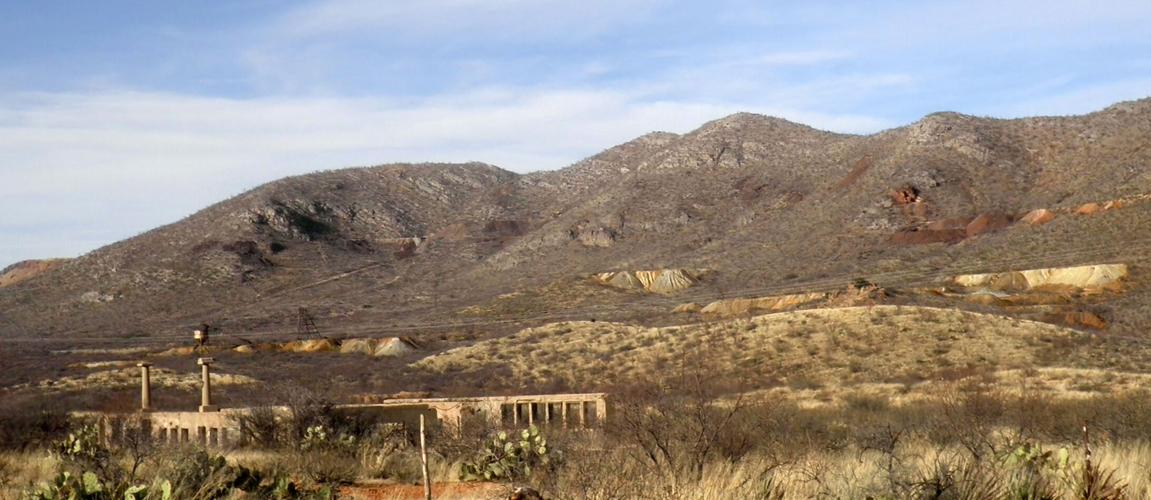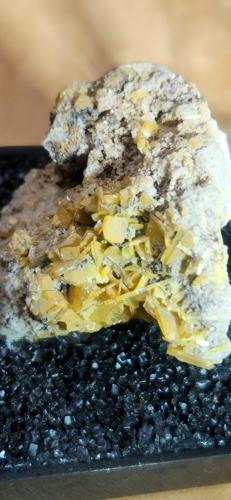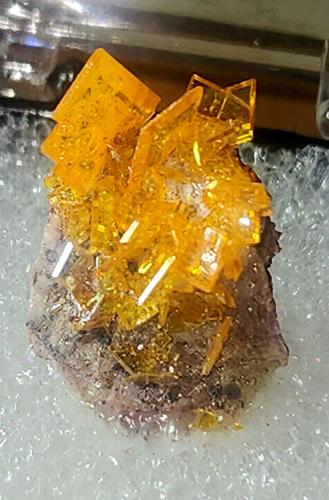The towns of Gleeson and Courtland along the old ghost town trail have an extensive history of mining operations.
They are located three miles apart in the Turquoise Mining district in the southeastern part of the Dragoon Mountain Range, about 15 miles east of Tombstone. The range itself extends northwesterly with a length of 26 miles and a width up to 12 miles.
Geologic activity in the district includes faulting and igneous intrusions. Rocks include quartz monzonite, granite and felsite. Principal ore deposits include copper, lead-silver and zinc. Turquoise can be found near the surface in stringers and lenses in altered granite and quartzite. Gleeson Ridge includes manganese deposits found in Pennsylvanian Naco limestone fractures.
This area was the site of early mining activities involving the Apache who worked the shallow surface deposits for turquoise and again by Anglo miners involved resurgence in turquoise mines sparked by a fashion trend involving the polished blue-green stone by the renowned Tiffany & Co. of New York. Silver-lead deposits were also worked around Gleeson.
John Collins is credited with having made the first mining claim in the district in 1877. Additional claims followed including those made by Josiah Bryant. The arrival of the Southern Pacific Railroad through Dragoon Pass in 1881 encouraged mining activity, though it was hindered in part by Apache raids until the surrender of Geronimo in 1886.
Timber for mining operations came in part from the Chiricahua Mountains 30 miles east. Water was secured from local wells averaging 30 to 100 feet deep, producing up to 15,000 gallons per day depending on the season.

Bono store and saloon in downtown Gleeson once served as a supply center for miners in the area.
Early production came from the Silver Bill and Gleeson mines classified as the Costello Group which included oxidized ore on the surface containing high-grade silver lead values along with limited gold and copper. Later production included the Tom Scott and Tejon mines.
A decline in silver prices in the 1880s led to the mining of oxidized copper ore deposits around Courtland.
By 1907, exploration and production in the district ran high due to activity among the Calumet and Arizona, Great Western and Phelps Dodge mining companies.
Christened after Courtland Young, one of two brothers who owned the Great Western Copper Mining Co., the town of Courtland was short-lived. It operated from 1909-13, when the shallow copper mines played out at several hundred feet below the surface.
At the height of their mining activity in 1910 both towns included a combined population of 1,500.
The nearby Germania Mine operated by the Calumet & Arizona Mining Co. and Phelps Dodge Corp. produced 76,500 tons of copper ore between 1909-40. The mine developed to a 500 foot main shaft later submerged by flood water.
Early transportation proved challenging as the town of Cochise, 30 miles north by wagon, was the nearest railhead to the Southern Pacific Railroad for shipping.

Looking east at mine tailings on Gleeson Ridge with remnants of old Gleeson School at base and the headframe and the water tower of the Copper Belle Mine, ca 2014.
By 1909 two railroads arrived to service the district hauling ore and passengers including the Arizona Eastern from Cochise and the El Paso and Southwestern from Douglas. The latter focused on hauling ore to the Douglas smelter for refinement 40 miles southeast.
Both encouraged greater copper production until being decommissioned 20 years later due to a decline in the local mines.
The Copper Belle Mine was the largest mine around Gleeson having been discovered by the town's namesake Irishman John Gleeson in 1896.
Gleeson’s mining experience involved the silver mines of the San Juan Mountains in Colorado.
Within five years the Copper Belle (Leonard, deposit) produced $280,000 gross profit with ore averaging 5 percent copper. Attempts to process ore onsite included roasting the sulfides in pits with juniper and later by copper furnaces with a capacity of 70 to 350 tons daily.

Thumbnail size specimen of wulfenite from the Defiance Mine northeast of Gleeson.
Later attempts in 1923 involved setting fire to mine works in the attempt to consistently burn sulfide ore bodies, followed by flooding the workings with water to dissolve the copper sulfates. Finally water would be pumped out and passed over iron scrap to precipitate the copper from the solution.
A more successful venture involved shipping the ore by a 30-mile wagon-haul to the railhead at Cochise for shipment to the Clifton smelter.
By 1907, the Shannon Copper Co. acquired the property from Gleeson for $100,000 and by 1922 had a documented 305,000 tons of ore haulage for refinement at Clifton.
The Defiance Mine on the southwest slope of Gleeson Ridge worked intermittently since the 1880s yielded 300 tons of ore containing 8-14% lead, some zinc and up to 7 ounces of silver per ton.
Workings include 440 feet of drifts and two 100 foot deep winzes. By 1958 it was credited with 10,000 tons of ore production.
Originally owned by Martin Costello who operated many mines in the area, it was augmented into the Calumet & Arizona Mining Co. as part of the Costello Group.
The Silver Bill Mine dates back to the rich oxidized silver-lead ore mined from shallow workings in the 1880s, later developed with a 271-foot inclined shaft and several hundred feet of workings in the 1890s. At the 200-foot level the mine connected by tunnel to the workings of the nearby Mystery Mine.
Up to 1,900 tons of ore per month — averaging 10 ounces of silver per ton — was shipped to the El Paso smelter for refinement. Owned by the Gleeson Heights Minerals Co., it was the last major operational mine in the district, closing in 1978.
Production history in the Turquoise Mining district from 1883 through the early 1970s included a minimum of 887 thousand tons of base metal ore including copper, lead and zinc and 250 tons of manganese ore along with turquoise and quartzite smelter flux.
The district produced notable specimens of wulfenite found at the Defiance and Silver Bill mines. Like other renowned wulfenite mine sites in Arizona including the Tiger, Hilltop, Rowley, 79 and Red Cloud mines those at Gleeson have distinct crystal formation and are highly collectable in today’s mineral market.
At present, the district hosts over 250 patented mining claims and is becoming more developed as a residential area.
While the mines played out decades ago, the potential remains for previously undiscovered lucrative mineral deposits and profit from existing tailings piles.

Small cabinet size specimen of wulfenite from the Silver Bill Mine northeast of Gleeson.

Micromount size specimen of pyrolusite from the Germania Mine.

Small cabinet size specimen of azurite with wulfenite from the Last Chance Mine, Casey Hill around Courtland.

Small cabinet size specimen of wulfenite from the Tiger Mine.

Thumbnail size specimen of wulfenite from the Hilltop Mine in the Chiricahua Mountains.

Thumbnail size specimen of wulfenite from the Rowley Mine.

Thumbnail size specimen of wulfenite from the 79 Mine.

Thumbnail size specimen of wulfenite, fluorite and calcite from the Red Cloud Mine.















